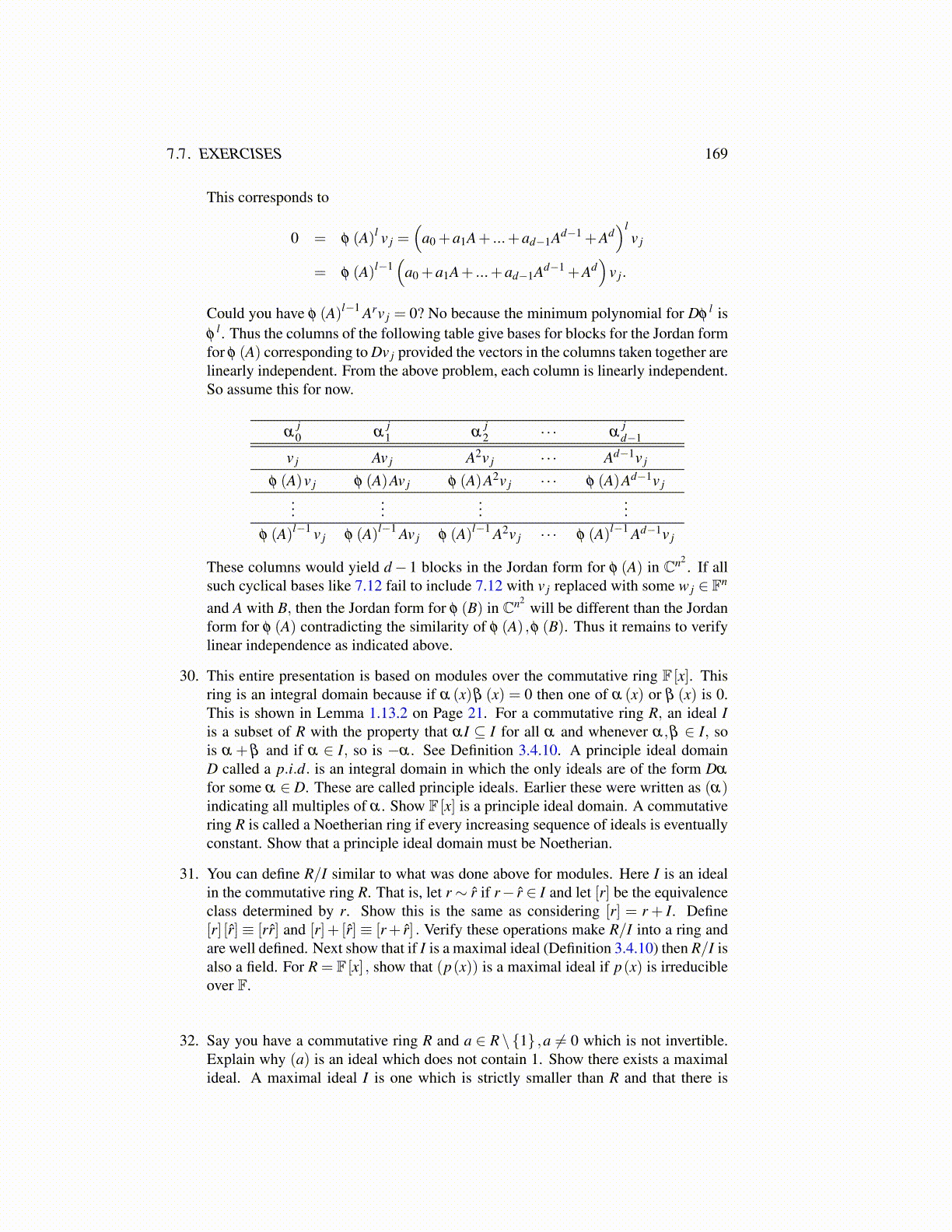
7.7. EXERCISES 169
This corresponds to
0 = φ (A)l v j =(
a0 +a1A+ ...+ad−1Ad−1 +Ad)l
v j
= φ (A)l−1(
a0 +a1A+ ...+ad−1Ad−1 +Ad)
v j.
Could you have φ (A)l−1 Arv j = 0? No because the minimum polynomial for Dφl is
φl . Thus the columns of the following table give bases for blocks for the Jordan form
for φ (A) corresponding to Dv j provided the vectors in the columns taken together arelinearly independent. From the above problem, each column is linearly independent.So assume this for now.
αj0 α
j1 α
j2 · · · α
jd−1
v j Av j A2v j · · · Ad−1v j
φ (A)v j φ (A)Av j φ (A)A2v j · · · φ (A)Ad−1v j...
......
...φ (A)l−1 v j φ (A)l−1 Av j φ (A)l−1 A2v j · · · φ (A)l−1 Ad−1v j
These columns would yield d− 1 blocks in the Jordan form for φ (A) in Cn2. If all
such cyclical bases like 7.12 fail to include 7.12 with v j replaced with some w j ∈ Fn
and A with B, then the Jordan form for φ (B) in Cn2will be different than the Jordan
form for φ (A) contradicting the similarity of φ (A) ,φ (B). Thus it remains to verifylinear independence as indicated above.
30. This entire presentation is based on modules over the commutative ring F [x]. Thisring is an integral domain because if α (x)β (x) = 0 then one of α (x) or β (x) is 0.This is shown in Lemma 1.13.2 on Page 21. For a commutative ring R, an ideal Iis a subset of R with the property that αI ⊆ I for all α and whenever α,β ∈ I, sois α + β and if α ∈ I, so is −α . See Definition 3.4.10. A principle ideal domainD called a p.i.d. is an integral domain in which the only ideals are of the form Dα
for some α ∈ D. These are called principle ideals. Earlier these were written as (α)indicating all multiples of α . Show F [x] is a principle ideal domain. A commutativering R is called a Noetherian ring if every increasing sequence of ideals is eventuallyconstant. Show that a principle ideal domain must be Noetherian.
31. You can define R/I similar to what was done above for modules. Here I is an idealin the commutative ring R. That is, let r ∼ r̂ if r− r̂ ∈ I and let [r] be the equivalenceclass determined by r. Show this is the same as considering [r] = r + I. Define[r] [r̂] ≡ [rr̂] and [r]+ [r̂] ≡ [r+ r̂] . Verify these operations make R/I into a ring andare well defined. Next show that if I is a maximal ideal (Definition 3.4.10) then R/I isalso a field. For R = F [x] , show that (p(x)) is a maximal ideal if p(x) is irreducibleover F.
32. Say you have a commutative ring R and a ∈ R \ {1} ,a ̸= 0 which is not invertible.Explain why (a) is an ideal which does not contain 1. Show there exists a maximalideal. A maximal ideal I is one which is strictly smaller than R and that there is